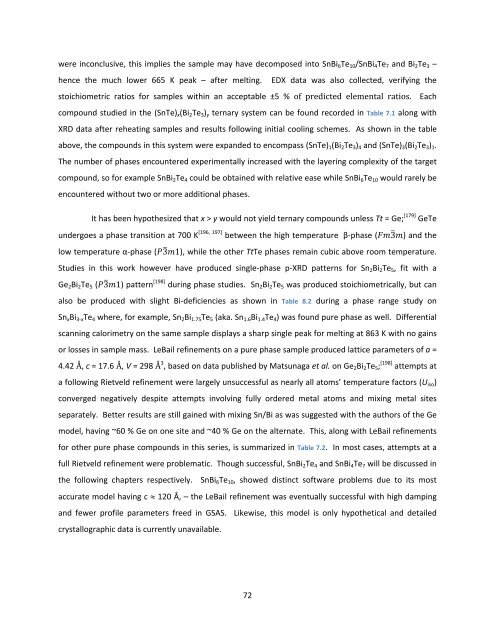Exploration and Optimization of Tellurium‐Based Thermoelectrics
Exploration and Optimization of Tellurium‐Based Thermoelectrics
Exploration and Optimization of Tellurium‐Based Thermoelectrics
Create successful ePaper yourself
Turn your PDF publications into a flip-book with our unique Google optimized e-Paper software.
were inconclusive, this implies the sample may have decomposed into SnBi6Te10/SnBi4Te7 <strong>and</strong> Bi2Te3 –<br />
hence the much lower 665 K peak – after melting. EDX data was also collected, verifying the<br />
stoichiometric ratios for samples within an acceptable ±5 % <strong>of</strong> predicted elemental ratios. Each<br />
compound studied in the (SnTe)x(Bi2Te3)y ternary system can be found recorded in Table 7.1 along with<br />
XRD data after reheating samples <strong>and</strong> results following initial cooling schemes. As shown in the table<br />
above, the compounds in this system were exp<strong>and</strong>ed to encompass (SnTe)1(Bi2Te3)4 <strong>and</strong> (SnTe)3(Bi2Te3)1.<br />
The number <strong>of</strong> phases encountered experimentally increased with the layering complexity <strong>of</strong> the target<br />
compound, so for example SnBi2Te4 could be obtained with relative ease while SnBi6Te10 would rarely be<br />
encountered without two or more additional phases.<br />
It has been hypothesized that x > y would not yield ternary compounds unless Tt = Ge; [179] GeTe<br />
undergoes a phase transition at 700 K [196, 197] between the high temperature β‐phase (3) <strong>and</strong> the<br />
low temperature α‐phase (31), while the other TtTe phases remain cubic above room temperature.<br />
Studies in this work however have produced single‐phase p‐XRD patterns for Sn2Bi2Te5, fit with a<br />
Ge2Bi2Te5 (31) pattern [198] during phase studies. Sn2Bi2Te5 was produced stoichiometrically, but can<br />
also be produced with slight Bi‐deficiencies as shown in Table 8.2 during a phase range study on<br />
SnxBi3‐xTe4 where, for example, Sn2Bi1.75Te5 (aka. Sn1.6Bi1.4Te4) was found pure phase as well. Differential<br />
scanning calorimetry on the same sample displays a sharp single peak for melting at 863 K with no gains<br />
or losses in sample mass. LeBail refinements on a pure phase sample produced lattice parameters <strong>of</strong> a =<br />
4.42 Å, c = 17.6 Å, V = 298 Å 3 , based on data published by Matsunaga et al. on Ge2Bi2Te5; [198] attempts at<br />
a following Rietveld refinement were largely unsuccessful as nearly all atoms’ temperature factors (Uiso)<br />
converged negatively despite attempts involving fully ordered metal atoms <strong>and</strong> mixing metal sites<br />
separately. Better results are still gained with mixing Sn/Bi as was suggested with the authors <strong>of</strong> the Ge<br />
model, having ~60 % Ge on one site <strong>and</strong> ~40 % Ge on the alternate. This, along with LeBail refinements<br />
for other pure phase compounds in this series, is summarized in Table 7.2. In most cases, attempts at a<br />
full Rietveld refinement were problematic. Though successful, SnBi2Te4 <strong>and</strong> SnBi4Te7 will be discussed in<br />
the following chapters respectively. SnBi6Te10, showed distinct s<strong>of</strong>tware problems due to its most<br />
accurate model having c 120 Å, – the LeBail refinement was eventually successful with high damping<br />
<strong>and</strong> fewer pr<strong>of</strong>ile parameters freed in GSAS. Likewise, this model is only hypothetical <strong>and</strong> detailed<br />
crystallographic data is currently unavailable.<br />
72
















